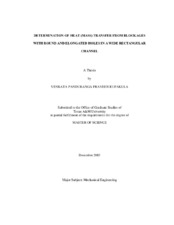| dc.description.abstract | Mass transfer experiments were conducted to study the thermal performance
characteristics of blockages with round and elongated holes, positioned in a 12:1
rectangular channel. Naphthalene sublimation technique was adopted to conduct
experiments with four different blockage configurations, flow rates corresponding to
Reynolds numbers (based on channel hydraulic diameter) of 7,000 and 17,000, and at
three blockage locations. The hole area to channel area ratio for all four blockage
configurations was the same at 0.196. The hole width was half the channel height, and
the distance between consecutive blockages was twice the channel height. Average heat
transfer, local heat (mass) transfer and overall pressure drop results were obtained. The
thermal performance for a particular blockage configuration was measured in terms of
the heat transfer enhancement and the friction factor ratio. Heat transfer enhancement
was measured as a ratio of average Nusselt number on the blockage surface to the
Nusselt number for a thermally fully developed turbulent flow in a smooth channel.
Results indicate that this ratio ranged between 3.6 and 12.4, while the friction factor ratio
varied between 500-1700. The blockage configuration with round holes was found to
yield best thermal performance, while the configuration with largest hole elongation was
nearly equal in thermal performance. In order to compare different blockage
configurations, an average value of upstream and downstream side thermal performances
was used. A general downward trend in Nusselt number ratio with elongation of holes was
observed on the upstream side and a reverse trend was observed on the downstream side.
An upward trend in the Nusselt number ratio with blockage hole elongation on the
downstream side of a blockage was primarily due to jet reversal from the downstream
blockage and its impingement on the downstream surface of the upstream blockage.
Local experiments were performed to compare against the results from average
experiments and also to gain insights into the flow behaviour. There was good
agreement between the results from local and average mass transfer experiments. The
average variation in Nusselt number ratio between local and average mass transfer
experiments was about 5.06%. | en |


